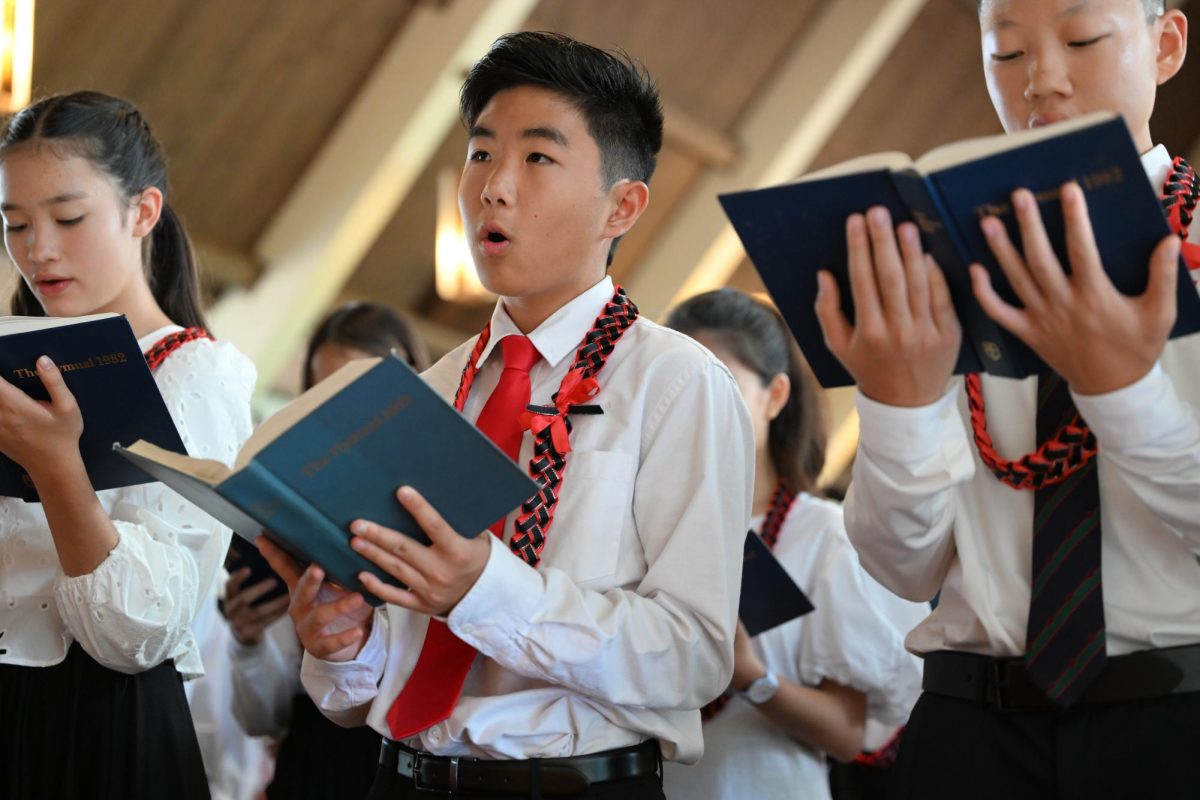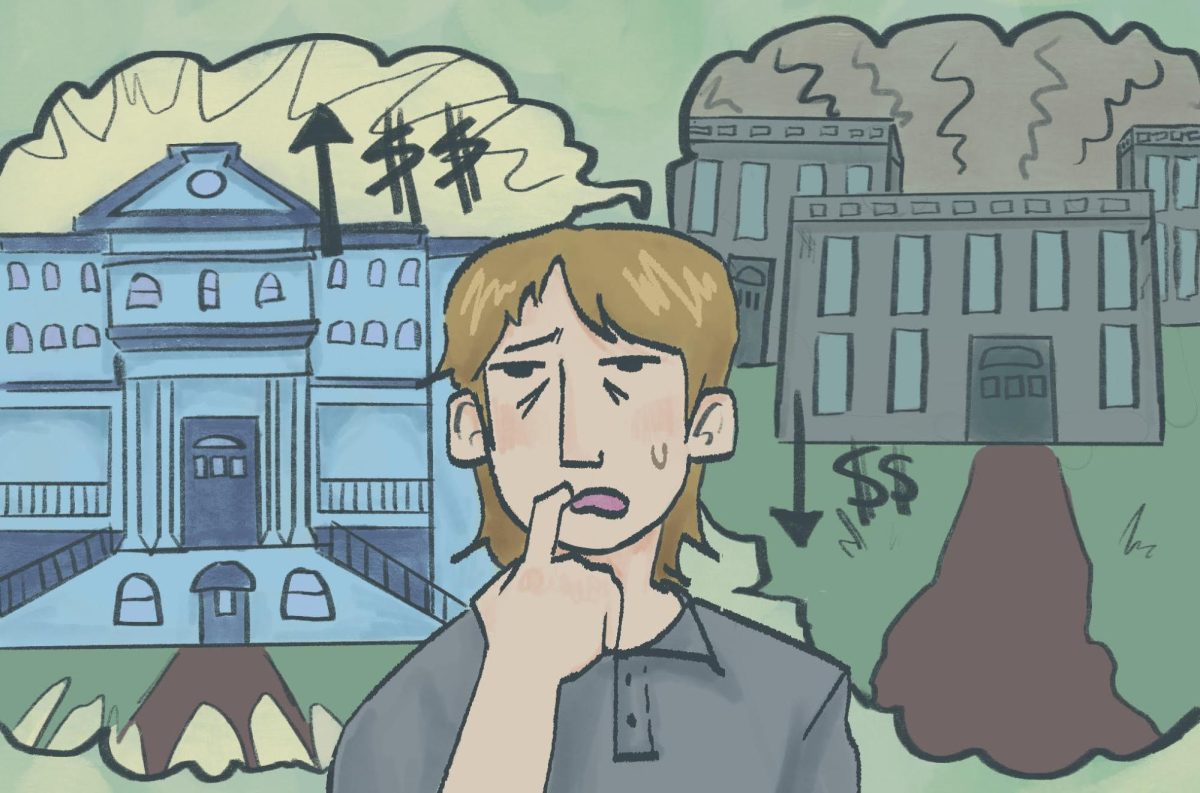Get ready because the sixth graders are about to start a new chapter by entering our Upper School community! The Moving Up Ceremony is a celebration that has finally arrived after all their hard work in Lower School. At the end of every school year in St. Alban’s Chapel, Lower School teachers and staff organize the Moving Up Ceremony, an event for sixth graders and their families to gather and say their final farewell to Lower School. This year, the event will take place on Thursday, May 30 at 8 am. This event is marked by songs, chants and tears, making it an unforgettable moment for the students. Students are acknowledged for their growth and progress as they are welcomed into the next chapter of their ‘Iolani journey. In addition, the Moving Up Ceremony has gained new traditions over the years, some of which were due to COVID-19. To help sixth graders transition to Upper School, seventh graders shared their advice with them.
Preparation for the Moving Up Ceremony
Behind the smooth-running and traditional event are many rehearsals and preparations during the last couple of months of the school year. Students and teachers devote multiple hours of their homeroom time to practice for the ceremony. Chaplain Andrew Arakawa often organizes rehearsals when students practice their formations in St. Alban’s Chapel. Everything is planned and rehearsed, from the moment the students line up to walk into the chapel to how they walk out. Along with formation and stance, students undergo musical rehearsals. With the help of Lower School music teacher Ms. Lindsay Rabe, students learn the ‘Iolani Alma Mater and a class song. “The whole purpose is that we choose a song in which the words convey their gratitude and love,” Mrs. Robin Watson, a sixth-grade teacher explains the teachers’ point of view in organizing the ceremony’s agenda. Another main part of the event is having Lower School Dean Mrs. Melaine Pfingsten and Dr. Timothy Cottrel share speeches. They tend to highlight the character and personality of the class as a whole, as well as the different experiences the class may have had since kindergarten.
Traditional Rituals and New Traditions
Despite the Moving Up Ceremony being known for its traditional rituals, the ceremony’s agenda has gained new traditions over the years. Alumni who attended ‘Iolani since sixth-grade can attest that their ceremony was not identical to today’s ceremony formalities. Years ago, the Moving Up Ceremony was called the Promotion. At the time, girls were required to wear skirts, and boys were expected to wear ties. Additionally, a class photo was taken every year on the Headmaster’s home lawn. Opposed to the current day, the house is gone and classes have become too large to fit into one picture. The dress code has also evolved since then. Girls are not currently expected to wear skirts, in fact, formal pants are appropriate as well, and boys do not need to wear ties. However, a recent modification to the shoe dress code has been put into place. It has been observed that students’ shoes, such as sports shoes, are not always appropriately matched with the ceremony’s formal attire. Teachers will be reinforcing this policy for future ceremonies. Besides gradual change over the years, another source that initiated change was the COVID-19 pandemic. The classes that graduated from Lower School during the pandemic had experienced a reduced version of the ceremony, but that didn’t prevent them from making another core memory. In the first year back from quarantine, the ceremony was broadcasted on Zoom for families to watch. Fortunately during the face mask phase, a maximum of two family members were allowed to come. On a smaller scale, an additional tradition formed that includes the seniors passing by the sixth graders during a singing rehearsal. This minor, but symbolic tradition gives the seniors a moment to reflect on how far they’ve come, and sixth graders take a moment to view the journey they have in front of them.
The Aura of the Moving Up Ceremony
There is something about the aura and the mood of the ceremony that brings the students, families and even teachers to tears. Any “outsider” watching it would be unable to understand the celebration’s depth unless they know the sixth grade students or have experienced the ceremony for themselves. “I think it’s just having students not realize how special this moment is until they walk into that chapel and see all of their families. They can feel the shift and then you can just see them taking everything more seriously,” Mrs. Watson added. She explains that when the sentimental shift of the moment settles into the students, the moment becomes surreal. Teachers work hard to organize and discipline the students into the fluidity of the ceremony, and the event itself is worth all the work that is put into it. Traditions that celebrate big milestones are often associated with great emotion. “We see the kids and parents sniffling, so it’s hard not to react to that.” Although the teachers aren’t directly related to the students, their role as organizers to ensure a wholesome moment sometimes catches them amidst the moment, leading to some sniffling or shivers in the skin.
How to Grapple with Transitioning to Upper School
Because transitioning from Lower School to Upper School is no easy task, students from the seventh grade shared their opinions on the subject matter. They were asked to share advice they would have wanted to know before joining the Upper School community. One student shared, “In Upper School, you need to use your planner and you cannot procrastinate like you can in sixth.” The academic aspect in Upper School is taken more seriously among students since the difficulty increases significantly. “Here, they expect perfection, and quizzes and tests are more common and difficult,” Callie N. ’29 said. It is a common opinion that the transition from Lower to Upper School is not all fun and games, but rather a new level of responsibility that the sixth graders will need to become accustomed to.
Being excited to transition into a new school environment not only comes with new freedoms but first requires students to reflect upon the experiences and loved ones that have molded them into the ‘Iolani student they’ve become. “I think they enjoy the fact that it’s finally over,” Mrs. Watson concluded. The sixth graders cherish the fact that all of their preparation of not only the Moving Up Ceremony but also their whole journey throughout Lower School has finally paid off. This could often lead students to think that it isn’t the transition itself that they look forward to, but more the idea of ending Lower School with loved ones who devote their hearts and tears towards their accomplishments.















